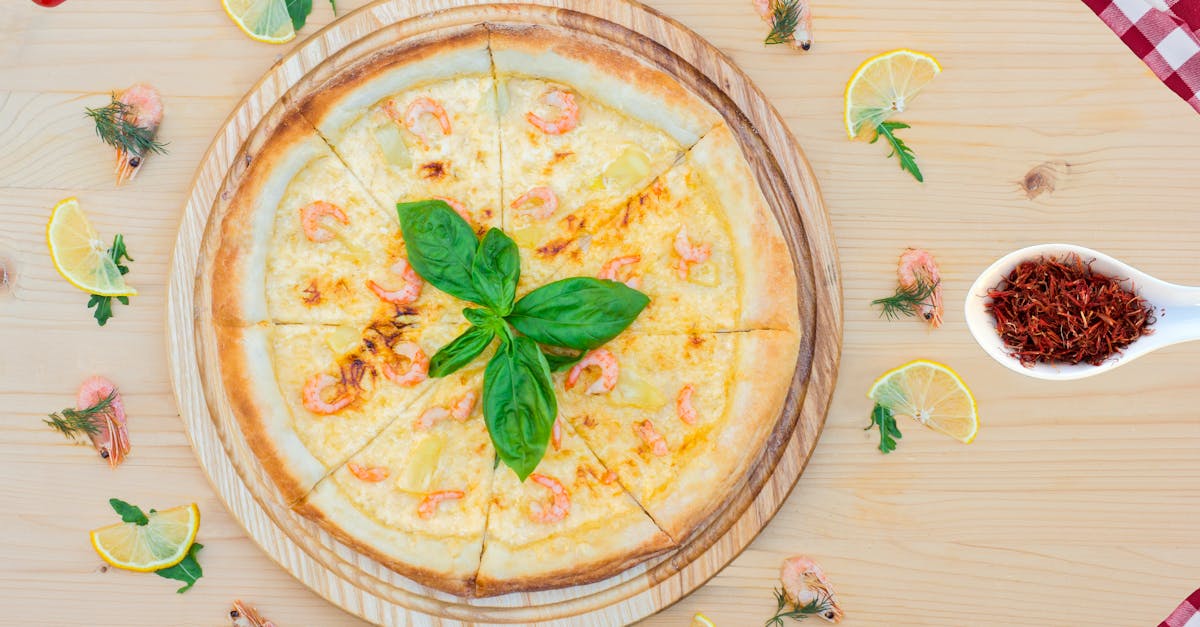Originally posted on March 11, 2025 @ 11:52 pm
When it comes to pizza, we all have our favorite toppings. Shrimp lovers might argue that seafood adds a unique flair to this beloved dish. But what if you’re not a fan of shrimp or simply want to try something different? Enter paneer, the versatile Indian cheese that’s creamy and rich in flavor.
Overview of Shrimp and Paneer
Shrimp and paneer represent unique culinary options that bring distinct flavors and textures to our pizza. Each topping appeals to different preferences, enriching our pizza experience.
Shrimp
Shrimp is a seafood choice known for its delicate texture and mild flavor. It’s often fondly described as having:
- Nutritious qualities: High in protein and low in calories, shrimp offers essential nutrients, including omega-3 fatty acids.
- Culinary versatility: Shrimp pairs well with various ingredients, including cheeses, vegetables, and spices, making it a suitable option for flavorful pizzas.
Quote: “Shrimp can elevate a pizza into a gourmet experience with its subtle sweetness and oceanic freshness.”
Paneer
Paneer, or Indian cottage cheese, stands out with its creamy consistency and mild taste. It’s a great alternative for those seeking vegetarian options, thanks to:
- High protein content: Packed with protein, paneer supports muscle health and provides energy.
- Culinary adaptability: Paneer absorbs surrounding flavors, making it ideal for pairing with spices and herbs.
| Nutritional Element | Shrimp | Paneer |
|---|---|---|
| Protein (per 100g) | 24g | 18g |
| Calories (per 100g) | 99 | 265 |
| Fat (per 100g) | 1g | 20g |
| Carbohydrates (per 100g) | 0g | 1g |
Quote: “Paneer’s mild nature allows it to shine when seasoned, making it a delightful topping on any pizza.”
In our culinary exploration, choosing between shrimp and paneer depends on our dietary preferences and the flavors we wish to experience. Each topping brings its own unique appeal, allowing us to customize our pizzas to suit our tastes.
Nutritional Comparison
When deciding whether to substitute shrimp with paneer on pizza, considering nutritional aspects helps us make informed choices. Both options bring distinct benefits that can enhance our meals in different ways.
Protein Content
| Ingredient | Protein per 100g | Protein Source |
|---|---|---|
| Shrimp | 24g | Animal |
| Paneer | 18g | Dairy |
Shrimp, known for its high protein content, provides around 24g of protein per 100g serving. It’s an excellent choice for those looking to boost protein intake while keeping calories low. Paneer, on the other hand, delivers about 18g of protein per 100g, offering a solid source, especially for vegetarians.
As nutritionists often say, “Opt for what’s best suited for your dietary needs.”
Vitamin and Mineral Differences
| Nutrient | Shrimp (per 100g) | Paneer (per 100g) |
|---|---|---|
| Vitamin B12 | 1.2µg | 0.7µg |
| Calcium | 60mg | 200mg |
| Selenium | 35µg | 14µg |
| Iron | 0.5mg | 0.6mg |
Shrimp provides a significant source of Vitamin B12 and selenium, crucial for nerve function and antioxidant support, respectively. Paneer shines with a higher calcium content, essential for bone health, and a good amount of iron, contributing to overall vitality.
Both ingredients offer unique advantages, letting us tailor our meals based on nutritional requirements or personal preferences.
Taste Profile and Texture
When comparing shrimp and paneer as pizza toppings, we experience distinct differences in taste and texture that influence overall flavor profiles. Each ingredient contributes uniquely to the dish, allowing for customized culinary experiences.
Flavor Characteristics of Shrimp
Shrimp brings a delicate, slightly sweet flavor profile to pizza. Its natural sweetness enhances the overall taste, often complemented by marinades or sauces.
- Mildness: Shrimp’s mild flavor typically welcomes bold spices and seasonings, making it a versatile choice.
- Umami Presence: The umami notes in shrimp elevate dishes, especially when combined with other savory ingredients.
- Cooking Methods: Grilling or sautéing intensifies the flavor, adding a slightly smoky note for a gourmet touch.
The table below highlights the flavor profile and characteristics:
| Flavor Aspect | Description |
|---|---|
| Sweetness | Slightly sweet, enhancing overall flavor |
| Mild Flavor | Pairs well with spices |
| Umami | Rich, savory notes that elevate taste |
| Cooking Method | Grilling or sautéing adds smokiness |
“The delicate flavor of shrimp complements various toppings beautifully.”
Flavor Characteristics of Paneer
Paneer introduces a creamy, mild flavor to pizza, making it a delightful vegetarian option. Its versatility shines through in various culinary applications.
- Creamy Texture: Paneer’s creamy consistency provides a rich mouthfeel, enhancing the overall experience.
- Flavor Absorption: Paneer absorbs surrounding flavors, allowing it to pair effectively with spices, sauces, and vegetables.
- Freshness: The fresh taste of paneer can balance richer toppings, providing a lighter option for pizza.
The following table summarizes the flavor profile and characteristics of paneer:
| Flavor Aspect | Description |
|---|---|
| Creaminess | Offers a rich and satisfying texture |
| Mild Flavor | Complements spices and sauces |
| Absorption | Captures surrounding flavors for depth |
| Freshness | Balances richer toppings for an enjoyable bite |
Recipes and Preparation Techniques
We can explore delicious recipes and preparation methods for both shrimp and paneer as pizza toppings. Each ingredient offers unique enhancements that elevate our pizza experience.
How to Prepare Shrimp for Pizza
To prepare shrimp for pizza, follow these straightforward steps:
- Choosing Shrimp: Select fresh or frozen shrimp; larger sizes like jumbo or tiger shrimp work best.
- Thawing: If using frozen shrimp, thaw in the refrigerator overnight or run under cold water for 10-15 minutes.
- Cleaning: Remove shells, tails, and any vein. Rinse under cold water and pat dry.
- Marinating: Combine olive oil, garlic, lemon juice, and seasonings. Marinate shrimp for 15-30 minutes to absorb flavors.
- Cooking: Sauté in a hot skillet for 3-4 minutes until pink and opaque. Avoid overcooking for tender texture.
Here’s a quick seasoning table for marinated shrimp:
| Ingredient | Amount |
|---|---|
| Olive oil | 2 tablespoons |
| Garlic (minced) | 2 cloves |
| Lemon juice | 1 tablespoon |
| Paprika | 1 teaspoon |
| Salt & Pepper | To taste |
“A light, citrusy marinade enhances the natural sweetness of shrimp.”
How to Prepare Paneer for Pizza
Preparing paneer for pizza adds a creamy and flavorful twist. Here’s how to do it:
- Choosing Paneer: Use fresh paneer for the best flavor. Store-bought options are convenient.
- Cubing: Cut paneer into bite-sized cubes or crumble it for more texture on the pizza.
- Marinating: Mix yogurt, turmeric, cumin, and chili powder for a flavorful marinade. Let paneer sit for 15-20 minutes.
- Sautéing: Lightly sauté cubed paneer in a pan with a bit of oil for 5-7 minutes until golden brown. This boosts flavor and texture.
- Layering: Add pre-cooked paneer on top of the pizza before baking, allowing it to melt slightly.
Here’s a quick marinade table for paneer:
| Ingredient | Amount |
|---|---|
| Plain yogurt | 1/4 cup |
| Turmeric | 1/2 teaspoon |
| Cumin | 1 teaspoon |
| Chili powder | 1 teaspoon |
| Salt | To taste |
“Paneer’s ability to absorb flavors enhances its role in any pizza topping.”
These preparation techniques make shrimp and paneer delicious alternatives for pizza, providing diverse flavors and textures that cater to different culinary preferences.
Conclusion
Whether we’re in the mood for the delicate taste of shrimp or the creamy richness of paneer our pizza can be a canvas for our culinary creativity. Both toppings bring unique flavors and textures that can elevate our pizza experience.
By choosing paneer, we embrace a vegetarian option that’s not only delicious but also nutritious. On the other hand, shrimp offers a seafood twist that can tantalize our taste buds.
Ultimately it’s all about what we enjoy and how we want to customize our slice. So let’s get adventurous and try both options to discover our favorite combinations. Happy pizza making!


